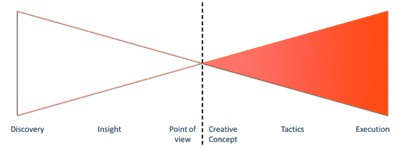
I started my career in consumer advertising. It was my job to tell a good story, change how people saw our products and get them to think: ‘A cheeseburger combo sounds great right about now.’ Simply put, it was my job to sell
a campaign.
Anyone who’s ever seen AMC’s hit TV show ‘Mad Men’, or who’s old enough to have watched Mel Gibson play the do-everything account executive in the classic flick, ‘What Women Want’ can tell you that advertising agencies are built to create campaigns. Some do it better than others but the goal is always to shake the market up with the biggest, most thought-provoking campaign the world has ever seen.
To get there, agencies start with research, filter down to a single insight and let the creative process take over. The biggest stage for most advertising agencies is the creative concepts presentation. For many in advertising, this 60-90 minute performance represents the culmination of the entire upfront strategic process. Traditionally, it is here the campaign starts to take shape, with tactics and programmes being developed to support that campaign.
 While this may be an overly simplified description of how the process works and how agencies drive value for their clients, it illustrates the point that most advertising agencies are structured to focus on the almighty campaign. In this traditional Bow-Tie model (Figure 1), everything works to get you to a great concept, and everything is set up to emanate from the resulting singularly focused campaign.
While this may be an overly simplified description of how the process works and how agencies drive value for their clients, it illustrates the point that most advertising agencies are structured to focus on the almighty campaign. In this traditional Bow-Tie model (Figure 1), everything works to get you to a great concept, and everything is set up to emanate from the resulting singularly focused campaign.
The problem is, while developing an exceptional creative campaign is imperative, strong campaigns alone do not guarantee sustained business growth. The reality is that changing one mindset is rarely enough to change the status quo. This is especially true in the healthcare sector. There are just too many players influenced by too many factors who need to change too many habits. You may be able to drive patients to their doctors with a compelling direct-to-consumer campaign and enjoy short-term success; but if physicians are not fully bought in, if nurses are unclear with implementation procedures, and if the product experience proves burdensome, the status quo is likely to remain unchanged. The traditional campaign-centric approach to brand strategy that advertising agencies have adopted for years is simply not designed to account for all of these different variables.
One of the main reasons advertising agencies struggle with clients viewing them as glorified design studios and not as true strategic partners is because agencies have become synonymous with the creative campaign. Brands today need advertising agencies to be much more than campaign factories. They need business partners. Brands do not need better campaigns, they need smart, creative problem-solvers who can help them dig into the details of their business and move the needle. Campaigns are still extremely important, but they should not be the centre of the universe.
An alternative to the campaign-centric approach to strategy is a new model called the Behavioural StratMap. As the name suggests, this approach focuses on behaviours that need to change and systematically maps out the path to brand growth. The fundamental principles of;
Map: You can’t get there unless you know how to get there
People used to look to the North Star to guide them to their destination. When they came to a fork in the road they’d trust the star to show them the way. While this is a romantic image, can you imagine having to find a new restaurant in an obscure but swanky upscale village on the other side of the city with just the stars to guide you? There is a reason we’ve adopted GPS technology. Getting from point A to point B is much more efficient and effective when you have a series of instructional steps to guide you. Brand strategy and brand growth are no different.
Most brands want the same thing: new orders, repeat orders and a loyal base of customers, and yet we are not currently spending time figuring out how we are going to get there, one behaviour at a time.
The Behavioural StratMap helps us get there. The first step is to identify the key players in the game who can directly or indirectly impact your business most; whether it’s the sales rep, HCP and patient, or lab director, technician and pharmacist. Then you plot out the series of desired behaviours that will lead to your desired outcomes. The more specific and concrete the actions are, the better.
The campaign has always been the North Star, but now you’ve got a map that details how you’re going to get where you’re going.
Measure: Are we there yet?
There are times I could have sworn I had lost 7-10 pounds after a good week of exercise and fairly healthy eating only to find that I weighed exactly what I did at the beginning of the week. I have also experienced the elation that comes with doing practically nothing and dropping a trouser size. What are we to learn from this? Well, first, I probably need to buy a new scale. But second, and more important, if we’re not measuring how close we are to achieving the desired behaviours we mapped out, then it’s impossible to know if we are allocating our resources appropriately and if we are successfully progressing toward our goal.
People love digital tactics because they are easily measured, but there are far more ways to measure progress toward a desired behaviour than just by looking at the back-end analytics of a digital project. There are gap scores, order rates, fulfilment trends, satisfaction surveys, perceptional analyses and a whole bevy of soft and hard metrics you can apply to track how the brand is progressing at each milestone in the process.
By measuring progress at each behavioural milestone you start to uncover holes, find untapped opportunities and build rationale to start prioritising the desired behaviours.
Monitor: Did you buy the milk?
Have you ever come home, proud of yourself for taking the initiative to go grocery shopping without being asked, only to open the door of the fridge to find it fully stocked? I have, and I can assure you that the duplicate items often go to waste, and waste stinks – literally.
The third step of developing a Behavioural StratMap is designed specifically to avoid waste. By overlaying the brand’s current set of assets, tactics and programmes to each milestone on the map along with its measurables, we can see how well stocked our brand’s fridge is. If the metrics show us that one particular milestone is a problem area, the Monitor step allows us to assess whether or not we have tactical holes and gives us an initial read on how our current efforts are doing.
Every brand can be more efficient and effective.
Motivate: Don’t always believe what you think
We’ve all heard the saying that if you can change the way people thinks, you can change their behaviour. But often the opposite is true. You have to first change people’s behaviour in order to change the way people think.
I look at politics today and at how many people passionately present their side of an argument, confident they can convince the other side to change the way they think. Discussion and debate is always good, but I can’t help but wonder if the only effective way for things to truly get resolved is if we just did what Maya Angelou reminded us to do; walk a mile in the other person’s shoes. Sometimes, it’s the action that changes minds.
The final puzzle piece in the Behavioural StratMap is effecting change at each of the behavioural milestones. Rather than looking for ideas to support a campaign, this step becomes a problem-solving exercise where any creative ideas that effectively address a specific desired behaviour are fair game. The questions we ask ourselves start working harder for us. Rather than broadly asking, ‘How can we raise awareness of our campaign?’ or ‘How can we change the way people think about our brand?’, we get the specificity of ‘How can we incentivise change to this particular behaviour?’.
With each change in behaviour along the series of milestones on the Behavioural StratMap, we get that much closer to our ultimate goal: not a new campaign, but rather sustained business growth and a new status quo. What else would you expect from your strategic partner?




